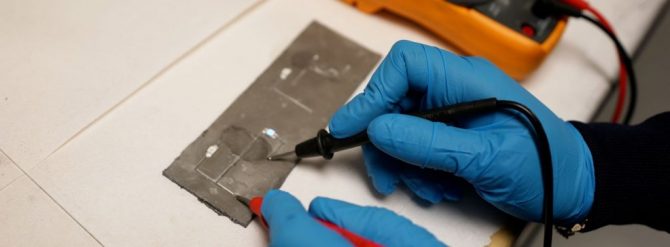Want a smartphone that stretches, takes damage, and still doesn’t miss a call?
A team of Virginia Tech researchers from the Department of Mechanical Engineering and the Macromolecules Innovation Institute has created a new type of soft electronics, paving the way for devices that are self-healing, reconfigurable, and recyclable. These skin-like circuits are soft and stretchy, sustain numerous damage events under load without losing electrical conductivity, and can be recycled to generate new circuits at the end of a product’s life.

Current passes through a self-healing circuit. Photo by Alex Parrish.
Led by Assistant Professor Michael Bartlett, the team recently published its findings in Communications Materials, an open access journal from Nature Research.
Current consumer devices, such as phones and laptops, contain rigid materials that use soldered wires running throughout. The soft circuit developed by Bartlett’s team replaces these inflexible materials with soft electronic composites and tiny, electricity-conducting liquid metal droplets. These soft electronics are part of a rapidly emerging field of technology that gives gadgets a level of durability that would have been impossible just a few years ago.
The liquid metal droplets are initially dispersed in an elastomer, a type of rubbery polymer, as electrically insulated, discrete drops.
“To make circuits, we introduced a scalable approach through embossing, which allows us to rapidly create tunable circuits by selectively connecting droplets,” postdoctoral researcher and first author Ravi Tutika said. “We can then locally break the droplets apart to remake circuits and can even completely dissolve the circuits to break all the connections to recycle the materials, and then start back at the beginning.”
The circuits are soft and flexible, like skin, continuing to work even under extreme damage. If a hole is punched in these circuits, the metal droplets can still transfer power. Instead of cutting the connection completely as in the case of a traditional wire, the droplets make new connections around the hole to continue passing electricity.
The circuits will also stretch without losing their electrical connection, as the team pulled the device to over 10 times its original length without failure during the research.
At the end of a product’s life, the metal droplets and the rubbery materials can be reprocessed and returned to a liquid solution, effectively making them recyclable. From that point, they can be remade to start a new life, an approach that offers a pathway to sustainable electronics.
While a stretchy smartphone has not yet been made, rapid development in the field also holds promise for wearable electronics and soft robotics. These emerging technologies require soft, robust circuitry to make the leap into consumer applications.
“We’re excited about our progress and envision these materials as key components for emerging soft technologies,” Bartlett said. “This work gets closer to creating soft circuitry that could survive in a variety of real-world applications.”
https://news.google.com/__i/rss/rd/articles/CBMiS2h0dHBzOi8vd3d3LmVwdC5jYS8yMDIxLzA2L3NvZnQtZWxlY3Ryb25pY3MtZG9udC1icmVhay1ldmVuLXdoZW4tcHVuY3R1cmVkL9IBAA?oc=5
2021-06-28 14:10:22Z
CBMiS2h0dHBzOi8vd3d3LmVwdC5jYS8yMDIxLzA2L3NvZnQtZWxlY3Ryb25pY3MtZG9udC1icmVhay1ldmVuLXdoZW4tcHVuY3R1cmVkL9IBAA
Tidak ada komentar:
Posting Komentar